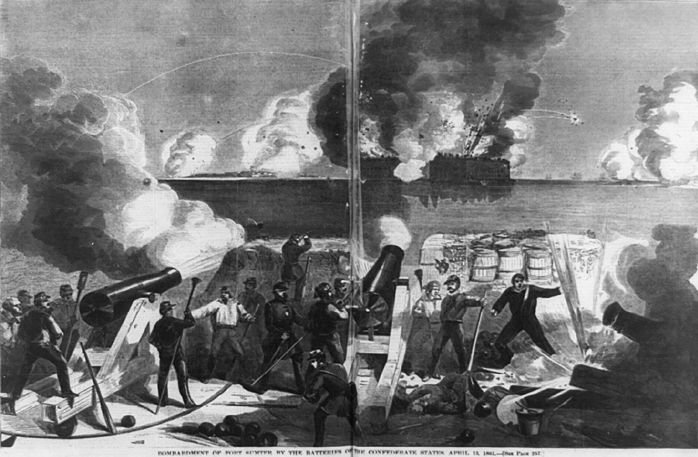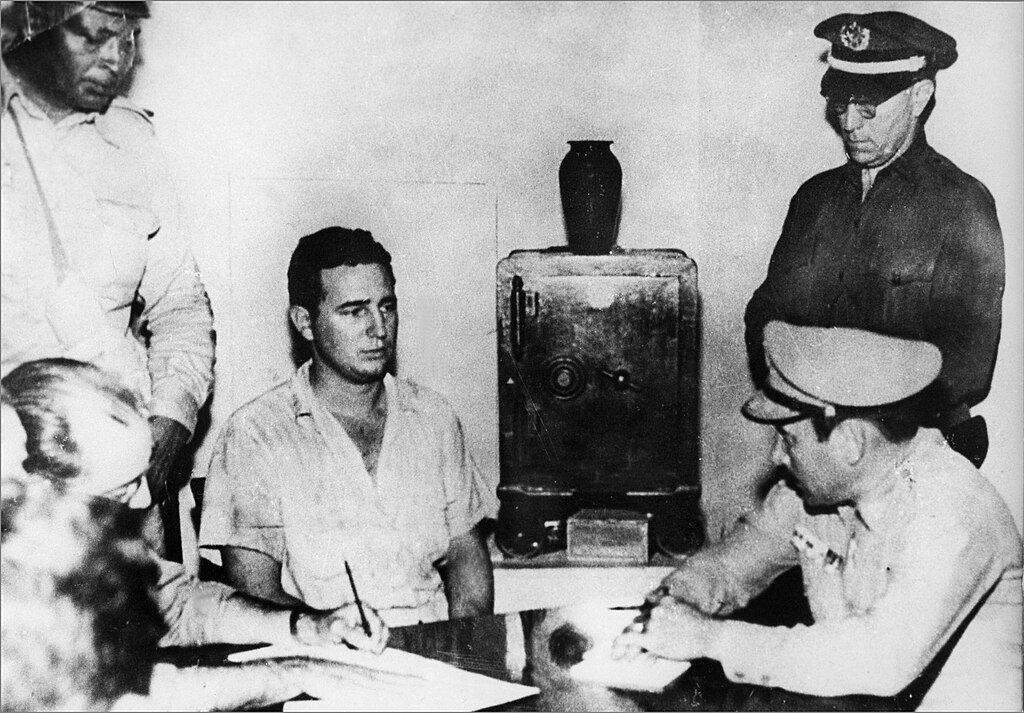British politician Winston Churchill was famously against the appeasement of Adolf Hitler and the Nazis in the 1930s. However, a public who still remembered World War One, were not altogether sympathetic towards these arguments. Here, Bilal Junejo looks at this period.
Winston Churchill and Neville Chamberlain in 1935.
“Appeasement” refers to “the response of British foreign policy makers in the 1930s to the rise of the dictator powers, especially Nazi Germany … it is seen as a policy of making one-sided concessions, often at the expense of third parties and with nothing offered in return except promises of better behaviour in the future, in a vain attempt to satisfy the aspirations of the aggressor states (Dutton, 2007).”
Appeasement arose as “an attempt to adjust the balance between the victorious and vanquished powers of the peace settlement of 1919 by concessions based on the widely held feeling that the terms of that peace had been unacceptably harsh (Dutton, 2007).” It would also be helpful to remember what is meant linguistically by the word “appease” — “to pacify or placate someone by acceding to their demands”, as per the Oxford English Dictionary. The meaning implies the presence of a choice for the appeaser. One does not “accede” to a demand when one does not have a choice in resisting it — one simply acquiesces therein! Since the application of the word “appeasement” to British foreign policy in the 1930s implies that there was nothing inevitable about that policy — that it could have been different, had its makers so chosen — we must consider the reasoning which was propounded at the time (i.e. without the benefit of hindsight) in favour of that policy, if we are to be at all able to determine just how realistic, in the sense of being practicable, were the arguments which Churchill put forward against it.
The doctrine of collective security, which was laid down in Article 16 of the League of Nations’ Covenant, stipulated that the League must present a united front in the face of unprovoked aggression against any member. However, “the basic premise of collective security was that all nations would view every threat to security in the same way and be prepared to run the same risks in resisting it (Kissinger, 1994, page 52).” In an organisation which boasted 60 different members from around the world at its greatest extent in the mid-thirties, this was never likely to be the case, least of all after the Great Depression’s advent in 1929, when the economic woes of Great Britain, one of the League’s principal ‘policemen’, not only precluded the imposition of meaningful economic sanctions by her upon an aggressor, but also necessitated the reduction of expenditure upon defence to the barest minimum required for national and imperial security. The League was only as strong as the collective will of its members, and since collective security, by definition, did not envisage unilateral action by a member, the stage was set for Great Britain, already riddled with moral doubts as to the peace settlement of 1919 and weakened by the Depression, to embark upon appeasement.
Japan - 1930s
First came Japan, in 1931. Then Italy, in 1935. Churchill, however, was selective in his opposition to appeasement. Whilst he adamantly opposed any manner of compromise with Hitler’s Germany to the last, he exuded no similar sentiment when Mussolini invaded Abyssinia, “[remaining] out of the country during the autumn of 1935 so as to avoid having to pronounce for or against Italy (Taylor, 1964, page 123).” Even after Mussolini’s assault upon Albania in April 1939, Churchill was able to say that the invasion was “not necessarily a final test … [since it appeared], like so many other episodes at these times, in an ambiguous guise (The Daily Telegraph, 13 April 1939, page 14).” In believing that Italy should be appeased, so as to retain her crucial goodwill in dealing firmly with Germany, Churchill was not alone, his views finding harmonious echoes in the thinking of men such as Robert Vansittart, who was permanent under-secretary at the Foreign Office from 1930-8. Churchill had two reasons for singling out Germany — her inherent economic and military strength, and the advent of Adolf Hitler.
Hitler’s rise
Hitler became Chancellor in January 1933. In October, Germany walked out of not only the otiose Disarmament Conference, but also the League of Nations, of which she had been a member since 1926! That she was able to do so with complete impunity was in itself a harbinger of what was to come — from the Anglo-German naval agreement of June 1935, to the Munich agreement of September 1938. In an early speech which, significantly, he delivered to his constituents at a fête in Theydon Bois, Essex — almost as though he were testing the mood of the people before he delivered the same remarks in the House of Commons and committed himself more palpably to the cause of anti-appeasement — Churchill warned that “at present Germany is only partly armed and most of her fury is turned upon herself. But already her smaller neighbours … feel a deep disquietude. There is grave reason to believe that Germany is arming herself … I have always opposed … all this foolish talk of placing [Germany] upon some kind of [military] equality with France … Britain’s hour of weakness is Europe’s hour of danger. I look to the League of Nations to rally the forces which make for the peace of the civilised world and not in any way to weaken them (The Times, 14 August 1933, page 12).” In other words, Germany could not be treated as an equal without resurrecting the military imbalance which had haunted Europe since 1871. There was no need for Great Britain either to ignore her own rearmament or to appease Germany by tolerating hers, least of all at the expense of France. Churchill’s principal apprehension was that a rearmed Germany would attack in the west — a fear which the British Government did not come to share until after the Nazi-Soviet Pact’s conclusion in August 1939, which explains why they reacted in the manner that they did to the subsequent invasion of Poland. But the fact remains that after remilitarising the Rhineland in March 1936, Hitler only moved eastwards. Would he have turned westwards after dismantling Poland, an Anglo-French ally, with Soviet help? In retrospect, Operation Barbarossa makes that seem somewhat unlikely.
If, as the appeasers believed, Hitler’s advent was only the culmination of German resentment at the invidious Treaty of Versailles, then the sooner that settlement was dismantled in favour of a more congenial one, the sooner would the wind be taken out of the Nazi sail, and stability return to Europe. But there was also the risk that alleviation of that resentment during the existence of the Nazi regime could actually fortify its national appeal. As a contemporary would eventually put it, “three main factors have militated against the growth of active opposition to the regime. In order of importance they are the success of German foreign policy, the absence of any apparent alternative to Hitlerism, and the success of the Government in combating unemployment (The Times, 2 January 1939, page 15).” As it was a catch-22 situation, Churchill saw no merit in strengthening a brutal regime with needless concessions, and was correct in fearing that appeasement would only send the wrong signal to Hitler.
Foresight
Churchill’s foresight, however, was not commonly appreciated. “It was partly Churchill’s extremely dangerous time on the Afghan-Pakistan border in 1896 and 1897, and in the Sudan in 1898, which had brought him up close to militant Islamic fundamentalism, that allowed him to spot the fanatical nature of Nazism that so many of his fellow politicians missed in the 1930s (Roberts, 2020, page 56).” As late as 1938, Anthony Eden, who had already resigned as Foreign Secretary over diplomatic differences with Prime Minister Neville Chamberlain, was arguing that “a settlement of the Sudeten German problem by conciliation is of the utmost urgency in view of the growing realisation of the far-reaching consequences of any resort to a decision by armed force in Central Europe (The Times, 12 September 1938, page 13)” — a settlement which was decried by Churchill as “a total and unmitigated defeat” on the floor of the House on 5 October 1938. The fact was that the appeasers not only believed that Nazi Germany would help counter what they considered was a bigger threat from Soviet Russia, but also remembered the horrors of the Great War — too vividly to recognise the import of caving in to Nazi bellicosity.
Conclusion
To conclude, acting upon Churchill’s counsel, the realism of which depended entirely upon the goals of its recipient, would have required rapid rearmament. Rearmament presupposed economic stability, which was already precarious at the time. But if the Government still believed, even in an era of Jarrow Marchers and an increasingly turbulent empire, that preserving a country which only (re)appeared on the map when both Germany and Russia were down and out in 1919 was vital to their own interests, then, with hindsight, it can be reasonably said that they should have issued an ultimatum when an infant regime committed its first act of overt “aggression” in March 1936 (Taylor, 1964, page 134). It might have averted another world war.
What do you think of Winston Churchill’s anti-appeasement in the 1930s? Let us know below.
Bibliography
Dutton, D. (2007) Proponents and critics of appeasement. Oxford Dictionary of National Biography [Online]. Available at: https://www.oxforddnb.com/view/10.1093/ref:odnb/9780198614128.001.0001/odnb-9780198614128-e-95646?rskey=aCl7MO&result=1 [Accessed on 22.11.22]
Kissinger, H. (1994) Diplomacy. Simon & Schuster Paperbacks.
Roberts, A. (2020) Leadership in War. Penguin Books.
Taylor, A. (1964) The Origins of the Second World War. Penguin Books.
The Times
The Daily Telegraph
















